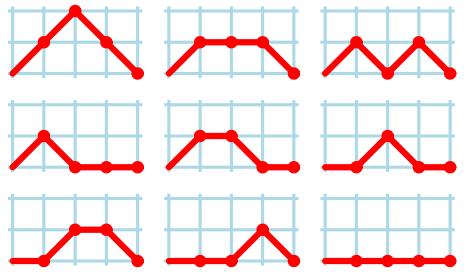题目链接:http://acm.hdu.edu.cn/showproblem.php?pid=3723
Delta Wave
Problem Description
-- from Wikipedia
The researchers have discovered a new kind of species called "otaku", whose brain waves are rather strange. The delta wave of an otaku's brain can be approximated by a polygonal line in the 2D coordinate system. The line is a route from point (0, 0) to (N, 0), and it is allowed to move only to the right (up, down or straight) at every step. And during the whole moving, it is not allowed to dip below the y = 0 axis.
For example, there are the 9 kinds of delta waves for N = 4:

Given N, you are requested to find out how many kinds of different delta waves of otaku.
Input
Output
Sample Input
3 4
Sample Output
4 9
Source
Recommend
思路:坐标是(0,0)和(N,0),所以向上了几次,就要向下几次。单独考虑向上向下,就是卡特兰数。考虑哪些上哪些下,就是排列组合。
卡特兰数公式:c[n] = c(2n, n) / (n + 1)。
如果上升了 k 次,那么就必须下降 k 次,所以方案数:a[k] = c(n, 2k) * c(2k, k) / (k + 1),k = 0,1,...,n/2。
因此,总方案数sum[n] = a[0] + a[1] + a[2] + ……+ a[k] (k <= n/2),且a[0] = 1(只有一个水平的)。
继续化简:a[k] = c(n, 2k) * c(2k, k) / (k + 1) 与 a[k - 1] = c(n, 2k - 2) * c(2k - 2, k - 1) / k,推出下列公式,
a[k] = a[k-1] * (n - 2 * k + 1) * (n - 2 * k + 2) / (k * (k + 1))。数据太大了,所以用Java实现比较方便。
附上AC代码:
import java.util.Scanner;
import java.math.BigInteger;
import java.util.Arrays;
import java.math.BigDecimal;
public class Main{
public static void main(String args[]){
Scanner in = new Scanner(System.in);
while (in.hasNext()){
int n = in.nextInt();
BigInteger ans = BigInteger.ONE;
BigInteger t = BigInteger.ONE;
for (int i=1; i<=n/2; ++i){
t = t.multiply(BigInteger.valueOf((n-2*i+1)*(n-2*i+2))).divide(BigInteger.valueOf(i*(i+1)));
ans = ans.add(t);
}
System.out.println(ans.mod(BigInteger.TEN.pow(100)));
}
in.close();
}
}





 本文深入探讨了在人类大脑中记录到的高振幅Delta波形,特别是与动漫迷(otaku)群体相关的特殊脑波模式。通过解析从点(0,0)到(N,0)的路径,该文详细解释了如何使用卡特兰数来计算在二维坐标系内形成不同Delta波形的数量。提供了具体示例和算法实现,帮助理解计算过程。
本文深入探讨了在人类大脑中记录到的高振幅Delta波形,特别是与动漫迷(otaku)群体相关的特殊脑波模式。通过解析从点(0,0)到(N,0)的路径,该文详细解释了如何使用卡特兰数来计算在二维坐标系内形成不同Delta波形的数量。提供了具体示例和算法实现,帮助理解计算过程。
















 1826
1826

 被折叠的 条评论
为什么被折叠?
被折叠的 条评论
为什么被折叠?








